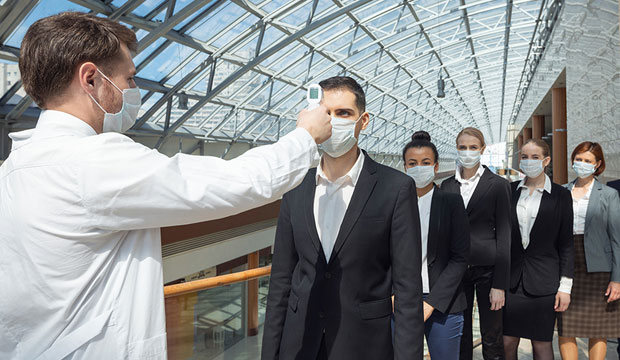A growing list of companies shares a common problem with Apple Stores. Technology may be the only solution as workers wait to return to their corporate workplace as the pandemic resurgence materializes.
Apple Stores recently tried to reopen but had to shut down again amid continuing COVID-19 infections. It only took a few weeks for Apple to close its retail stores after reopening to the public, sending its employees back to work from home. Many companies are likely to follow suit as coronavirus cases continue to spread.
For those business that got it right reopening their workplaces the first time around, they should be in pretty good shape for round two. But others that struggled to get a handle on operations will likely find themselves again in chaos — especially where IT is concerned for the transplanted work-from-home employees.
Unsolved challenges exist in either scenario. No one formula is an ideal approach for companies going back-and-forth between in-person and remote work. The lessons learned from the first transition suggest companies with the right tools and strategies in place will be significantly better off.
Most organizations will face common challenges with staff working in the same space again:
- How do they use elevators in office buildings?
- How do they cater in the cafeteria?
- Do employees still have access to the break room with common appliances and a shared space?
- How do employees organize meetings in conference rooms that are meant for a specific number of attendees?
These are the basic questions confronting business managers as they race to reopen their workspaces to large crowds of workers, observed Mounir Hahad, head of Juniper Threat Labs at Juniper Networks.
One of the serious challenges involves not only the health of employees but the health of company electronics. Those issues persist whether employees work from home or return to the office.
“Unfortunately, during these times when many organizations have been forced to shift to a more distributed business model, hybrid work practices are causing organizational challenges related to rising cybersecurity risk, defenses being tested, and weaknesses being exposed,” Hahad told TechNewsWorld.
Business continuity may lighten up or override previous security requirements to address system overload, which leaves vulnerabilities open. Companies must find a way to ensure cybersecurity remains a top priority and keep their guard up.
“It is especially important that organizations emphasize employee education around cybersecurity,” he urged.
Addressing Risks
Some advanced WiFi access points do have the ability to precisely monitor users’ locations throughout their workday as they move around the buildings and record the data for future use. This is of tremendous help to the security and safety team who can identify hot spots where employees tend to congregate, or to trace back the proximity of an infected employee to other employees or visitors, noted Hahad.
Additionally, hybrid work environments can identify new opportunities for organizations to reassess their business continuity plans and network security processes. As early experiences suggest, transparency, flexibility and iteration are key in return-to-workplace plans amid possibly several rounds of back-and-forth restarts, depending on COVID-19 infection rates.
“Businesses must continue to address the ways employees connect to the network and how to deploy technology to enable and protect those connections, regardless of work environment,” Hahad said.
Common Challenges
Navigating the remote-to-office scenario that companies face to regather their workforces is stressful for both the displaced workers and their company managers.
Coworkers will spend an inordinate amount of time reconnecting early on, which will likely have a large impact on productivity at first, suggested Chris Triolo, vice president of customer success at Respond Software.
“Employees may struggle with productivity as they adapt back to the office environment. The return of the commute may affect employees’ happiness temporarily and likely will result in fewer hours worked per day,” he told TechNewsWorld.
Two other primary issues surface in the WFH-to-office return flip flops. One is the Security Operations Center (SOC); the other is the deployment of corporate communications assets.
“While some industries are suited for remote work, there are several industries for whom this working style presents many problems,” Triolo noted.
For instance, cybersecurity operations is not an industry that should operate remotely long-term. Home offices tend to be on “unsafe” networks that lack all the security controls and technology that the corporate office maintains.
Another consideration is what to do with corporate assets, such as laptops and phones that were distributed. Are companies expected to collect them all upon return? A good deal of logistical work comes to mind with this scenario.
“While everyone does appreciate a change now and then, we risk employees’ focus, happiness, and productivity by see-sawing back and forth between in-person and remote work. While some companies have run a hybrid model all along, most employees who are new to the work-from-home and/or the hybrid structure may really struggle with it,” Triolo explained.
Lessons Learned
The first transition from office to WFH taught company managers some surprising lessons. Many companies learned for the first time that it is possible to have a remote workforce.
In addition, the productivity question was resolved: employees ended up just as productive — and in some cases more productive — than when they worked in the office full time.
“We also began to recognize that remote employees can reduce the costs of running our business, for example, with the leasing of office building space, decreased spending on utilities, and day-to-day overhead costs,” Triolo noted.
But businesses also learned that we had a lot of work to do to get our employees the tools they need to work from home safely. These include laptops, corporate VPNs, and other collaborative tools such as Zoom, Slack, and Microsoft Teams or Google Meet.
“There was an initial scramble to put the technology and policies in place, but now that we’ve done it, we can move from the office-to-home work lifestyle again much more easily,” he said.
The lessons businesses learned include a need for planning and major adjustment when it comes to making the switch between working at the business premises and remotely, according to Melissa Cadwallader, HR leader at ZenBusiness.
“Businesses were initially required to make provisions for continued communication with socially distanced employees. There has also been a need to focus on the health and safety of those workers expected to return after the months of isolation. The wearing of face masks and arrangement of worker shielding has become the new workplace norm, given continuing concerns over the pandemic,” she told TechNewsWorld.
The Journey Back
Transitioning back to the office will present companies with a need for the change and adoption of policies for the protection and engagement of employees going back and forth between in-person and remote work. There will also be a challenge when it comes to maintaining business as normal, Cadwallader offered.
“Employees have to adapt to different working practices. There may well be a decrease in productivity and engagement given the continued uncertainty over working arrangements,” she said.
The remote-to-office scenario poses serious challenges for companies from a health standpoint. It is opening more doors for COVID-19 contraction, warned Craig Williams, CIO at Ciena.
“If employees coming into work have been quarantined, making them come into the office raises the question we seem to forget in the equation — how did they get to work? If the answer is by public transportation such as a train or bus, then the risks of exposure are further expanded,” Williams told TechNewsWorld.
Then there is the liability issue that companies face in reopening corporate workspaces, warned Williams. Even if all the employees drove to work with their own cars so their exposure rates are low, without the right socially-distanced office setups — like plexiglass shields between cubicles — companies are facing immense liabilities by opening back up too soon and putting not only employees but their families at risk as well, he explained.
“The first transition has clearly outlined why it is too soon to open back office spaces without taking all the right precautions, and it has also shown that perhaps even with all the seemingly right precautions, the virus can still run rampant.
“Many employees are hesitant about going back to the office right now so companies must use this as an opportunity to listen and follow their lead,” he suggested.
Growing Opposition
Remote workers made to rush back to the office too soon may actually choose to quit instead. According to a survey by Azurite Consulting that tallied the views of 3,500 people, one-in-four office workers would quit if asked to return too soon. That includes 26 percent of employees and 21 percent of managers.
Key findings from that survey include:
- 54 percent of high-risk employees want to continue working remotely.
- 70 percent of Americans see taking public transportation to work as unsafe.
- To foster a safe return, office workers want face masks and investment in better hygiene before they return. A majority (56 percent) want mandatory face masks, while 42 percent want sanitizers or disinfectants at their desks, and 36 percent want reduced office capacity at any given time.
- 15 percent want daily temperature checks, and 16 percent want weekly COVID-19 testing.
The Azurite survey also revealed:
- 54 percent of companies in major downtown centers have intent to downsize their footprint, and 55 percent plan at least some relocation of employees.
- 11 percent of urban dwellers contemplate a suburban move and 25 percent a rural move. Meanwhile, 28 percent of suburban dwellers contemplate a rural move.
“We are reaching a point where companies are looking to get people back in their office spaces, but clearly we can’t resume pre-pandemic practices. Leaders now have to manage the influx of people arriving to high-rise office buildings in densely populated cities like Chicago and New York. Workers need to access the building, go up elevators and get to the office as safely as possible,” Matt Fairhurst, CEO and cofounder, Skedulo — a deskless worker productivity software company — told TechNewsWorld.
Some spaces have made new rules limiting the number of people in an elevator or have enacted social distancing. Companies are taking it upon themselves to phase people back into the office. This involves limiting the capacity of employees allowed on a given day. “But how can we more effectively manage this?”, he questioned to illustrate the issues involved with return workers to corporate offices.
Potential Answers
Skedulo could have a solution to easing and managing the transition back to the office. The company is exploring the idea of applying high capacity-based scheduling technology, Fairhurst announced. That software automatically and intelligently helps organize large quantities of people using appointments to enter the office.
“Think about scheduling workers’ arrival times, limiting the number of people in elevators, and taking into account the total number in an office, especially for large companies with one central office. This can be overwhelming to manage,” he said.
If too many individuals arrive at once, people could congregate in the lobby, possibly breaking social distancing rules and increasing the risk of spreading COVID-19. Using capacity-based scheduling, an employee could check if a low volume window is available to work in the office, book his/her arrival time, check-in via a contactless QR code at the front desk, and ride up the elevator. All of that would follow appropriate social distancing measures with the knowledge you will not be turned away at the front door.
“The technology can automate appointments and triage if there is a backup somewhere, meaning if a cluster of people arrives at once, it can intelligently reschedule the rest of the day, helping reduce potential exposure,” said Fairhurst.
























































We’re seeing the new set of challenges for our business as well. Silver lining- at least our work/life balance has been considerably improved!
There is no virus, this is the mask to mask the planned economic world collapse. The banks dont want to be blamed. If the masses keep wearing the slave mask, it will get much worse. Of course, you must have sold out to the agenda to even report this rubbish